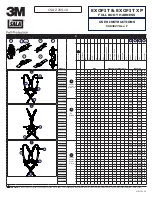
25
7 Digital Communications
7
Digital Communications
The calibrator is capable of communicating with and being controlled by other equipment
through the digital serial interface.
With a digital interface the instrument may be connected to a computer or other equipment.
This allows the user to set the set-point temperature, monitor the temperature, and access any of
the other controller functions, all using remote communications equipment. Communications
commands are summarized in Table on page .
7.1
Serial Communications
The calibrator is installed with an RS-232 serial interface that allows serial digital communica-
tions over fairly long distances. With the serial interface the user may access any of the func-
tions, parameters and settings discussed in Section 8 with the exception of the baud rate setting.
7.2
Wiring
The serial communications cable attaches
to the calibrator through the D-9 connec-
tor at the back of the instrument. Figure 5
shows the pin-out of this connector and sug-
gested cable wiring. The serial cable should
be shielded. If the unit is used in a heavy
industrial setting the shielded cable must be
limited to
one
meter.
7.2.1 Setup
Before operation the serial interface must
first be set up by programming the baud rate
and other configuration parameters. These
parameters are programmed within the serial
interface menu. The serial interface param-
eters menu is outlined in Figure on page .
To enter the serial parameter programming
mode press “SET” and “EXIT” simultane-
ously to enter the secondary menu. Press
“SET” repeatedly until the display reads
PAr
. Press “UP” until the serial interface
menu is indicated with
SERIAL
. Finally press
“SET” to enter the serial parameter menu. In
the serial interface parameters menu are the
baud rate, the sample rate, the duplex mode,
and the linefeed parameter.
Figure 5 RS-232 Cable Wiring
1.888.610.7664
Fluke
-
Direct
.com










































